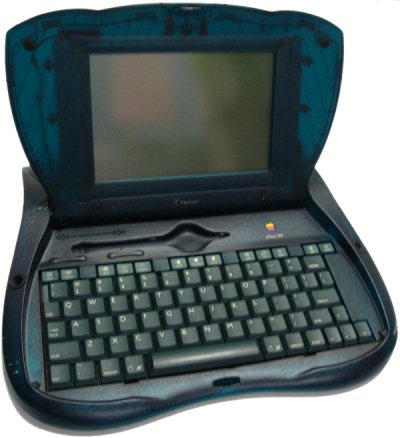Mobile LinuxWorld: A tale of two Palms
Regular readers know that I spent 15+ years as an Apple Computer ISV and did my dissertation on Apple’s missteps and struggle for survival in the 1990s. I published a book chapter that IMHO is the definitive treatment (thus far of their woes), plus another paper on the operations and e-commerce aspects of their turnaround.
During Apple’s troubles, many of its employees bailed to the next great thing in computing platforms, i.e. Palm Computing, founded in 1992. Palm picked up a lot of Apple people and from the outside it seems like Palm picked up much of the Apple culture. Now it seems to be reprising Apple’s woes, but a decade later and with a different root cause.
Since 2003, the company founded by Jeff Hawkins has been split into two. (In fact, I met my now-coauthor Mike Mace back in May 2002 when we tried to get Palm to let me study the split.) Palm originally split into PalmOne (hardware) and PalmSource (software), but PalmOne immediately bought rival Handspring to get Hawkins and Donna Dubinsky back.
When PalmOne (now Palm) bought back an OS license and the trademark from PalmSource, I assumed that its future was stable. Meanwhile, PalmSource — deprived of its only remaining major customer, seemed doomed, particularly after it was bought by Access, an obscure Japanese web browser company.
After my visit to LinuxWorld, I’ve pretty much done a 180°. The PalmSource strategy today makes a lot of sense, whereas I still can’t figure out what Palm Inc. is going to do to survive.
Palm was showing the Foleo, the “mobile companion” unveiled to great hoopla in May. At the booth they said the Foleo is due to ship “this summer” (which I pointed out would have to be sometime in the next 6 weeks). Fitting the Apple legacy, the Foleo is a lot like the eMate 300 — Apple’s last gasp to save Newton PDA by making one with a bigger screen and a keyboard. The Foleo is somewhere between a PDA and a laptop in price and capabilities. The one difference is that it doesn’t run PalmOS, it runs Linux; during LinuxWorld Palm announced it would use the WindRiver Linux distribution from now on.
Fitting the Apple legacy, the Foleo is a lot like the eMate 300 — Apple’s last gasp to save Newton PDA by making one with a bigger screen and a keyboard. The Foleo is somewhere between a PDA and a laptop in price and capabilities. The one difference is that it doesn’t run PalmOS, it runs Linux; during LinuxWorld Palm announced it would use the WindRiver Linux distribution from now on.
I see three problems with the Foleo. First, it’s neither fish nor fowl so the market may not understand it. Although it had some dedicated owners, the eMate was no great market success. And since then, laptop computers have fallen below $800, eliminating the price argument for the most price sensitive. Second, it’s a new platform, with a new ecosystem and a new user training curve. If desktop Linux were established, a slimmed-down Linux subnotebook could be a smash hit. As it is, there are few desktop Linux apps. Even if there were, they wouldn’t run because Palm went off and invented their own UI because (unlike Motorola or PalmSource) they didn’t like GTK or the other technologies that seem to be coalescing in the Gnome Mobile initiative.
Second, it’s a new platform, with a new ecosystem and a new user training curve. If desktop Linux were established, a slimmed-down Linux subnotebook could be a smash hit. As it is, there are few desktop Linux apps. Even if there were, they wouldn’t run because Palm went off and invented their own UI because (unlike Motorola or PalmSource) they didn’t like GTK or the other technologies that seem to be coalescing in the Gnome Mobile initiative.
Finally, there are already devices in this intermediate position. They’re called smartphones, specifically the Nokia Communicator series of phones, which have been shipping to European loyalists since 1996.
† Before $100 rebate
Nokia Palm HP E90 Foleo nc2400 Price ~~ $1100 $599† $1400 Weight 7.4 oz 2.5 lbs 2.9 lbs Screen size 10.2" 12.1" Resolution 800x352 1024x600 1280x800 Keyboard mini compact standard Wi-Fi yes yes yes Phone GSM - - Optical drive - - CD-RW/DVD-ROM OS Symbian 9.2,
S60 Rev 3.1Linux 2.4,
proprietary UIWindows XP Applications thousands built-in hundreds of thousands
The Nokia is smaller, more portable, and makes phone calls to boot. Plus the new ones share a common platform with 70+ million S60 phones out there. Ordinary laptops also are available for a slightly higher price at roughly the same weight. So if I were an internal MIS dept., would I choose to develop for the world’s leading cell phone maker (with a 12-year track record on this product family), the ubiquitous PC platform, or the last surviving firm in a dying product category with its brand new and unproven platform?
The only advantage is the price: it’s cheaper than the most portable business-oriented computers (or the Nokia), although still quite a bit above the $200 of today’s OLPC price.
Technorati Tags: embedded Linux, Linux, mobile phones, Palm

![[feed]](http://photos1.blogger.com/x/blogger2/6971/993546936938810/1600/z/962294/gse_multipart3851.gif)

No comments:
Post a Comment